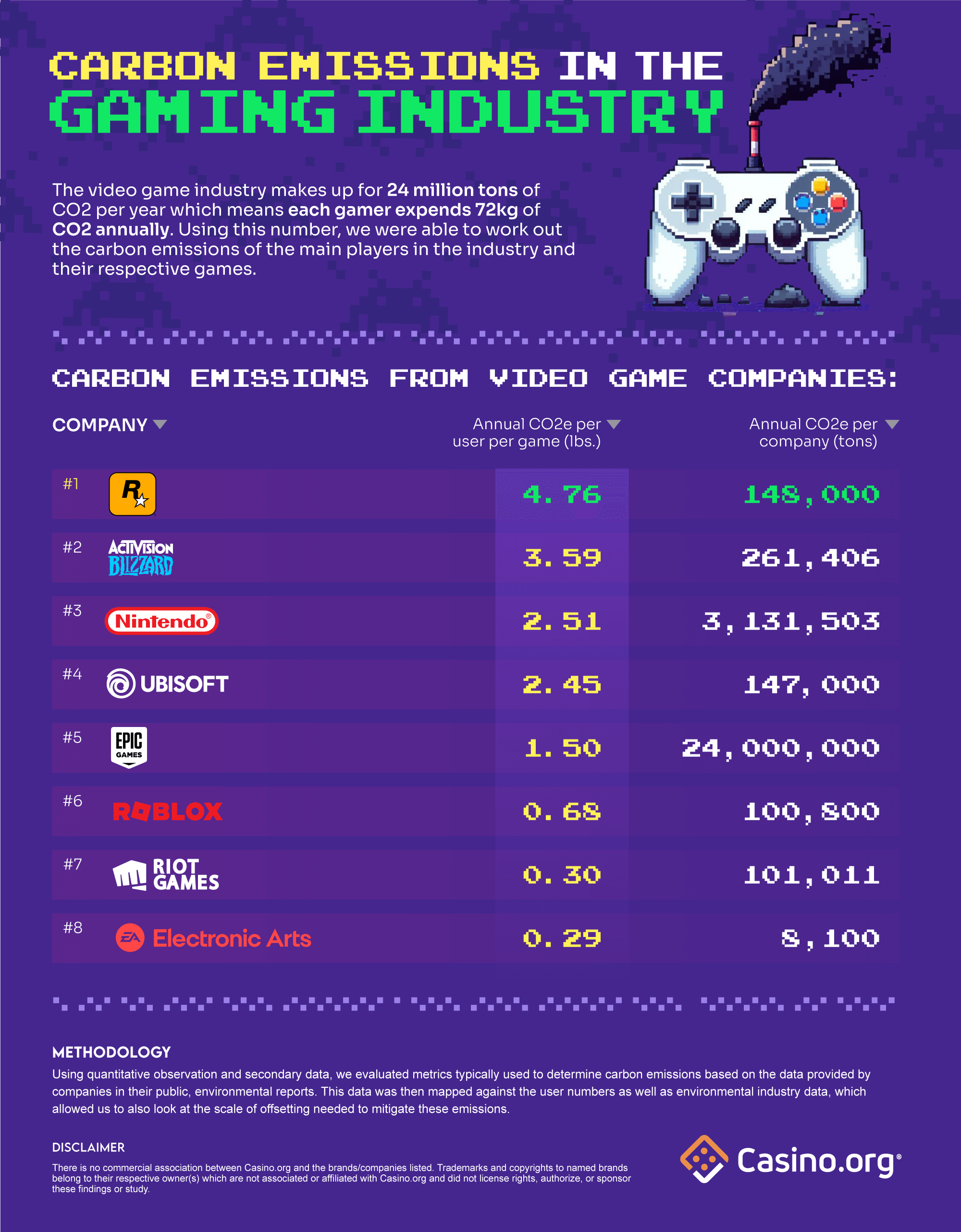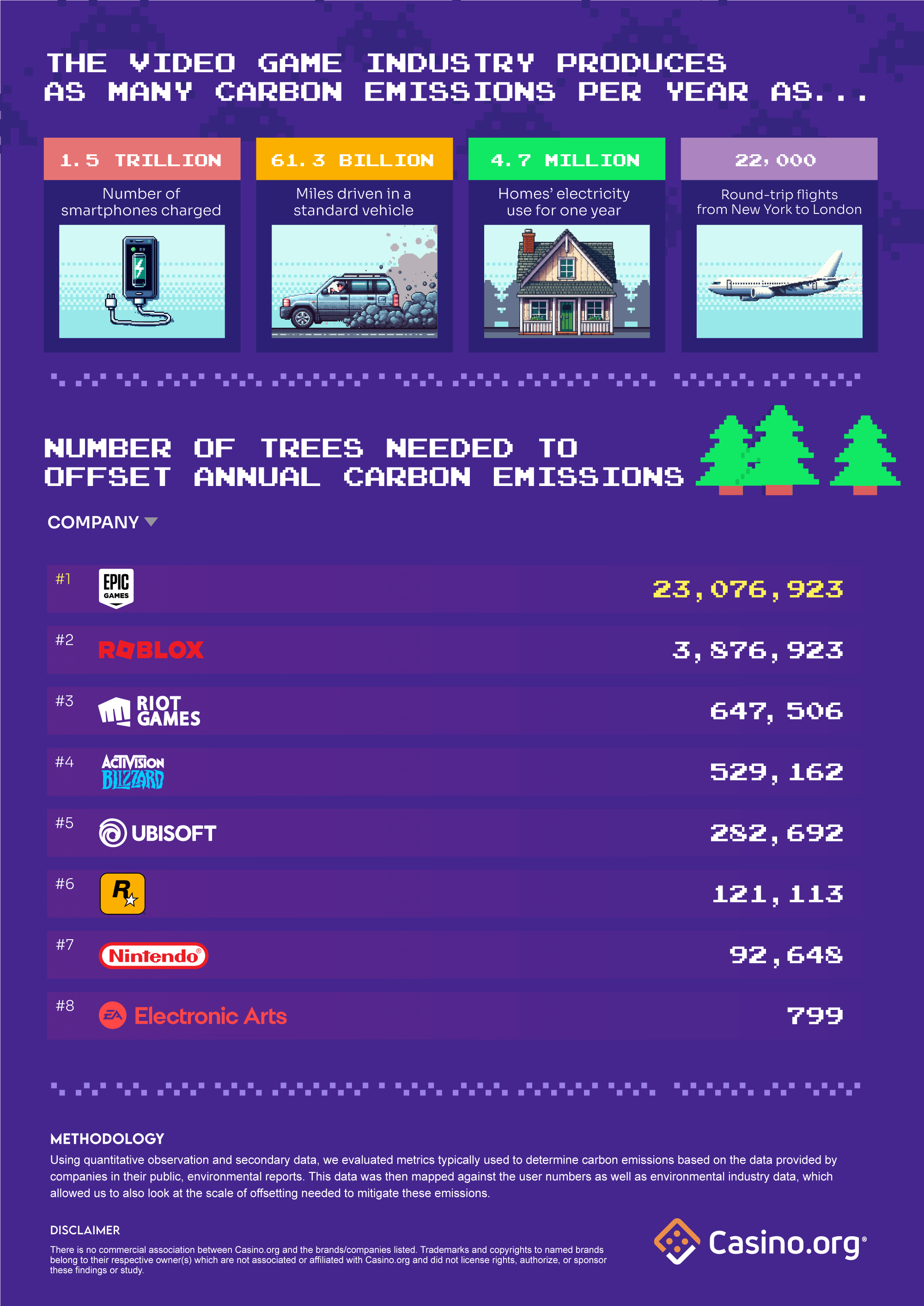Gaming Industry Study: Carbon Emissions of Top Video Games
What do video games and jumbo jets have in common? Carbon emissions, of course! Although we have to consider scale, video games, much like diesel tanks, airplanes, and oil factories also have an effect on carbon footprint. Whether you’re bashing away at the controller in Call of Duty or galivanting through virtual fields in The Sims, our digital actions can have real-life implications.
Although more and more video games are moving away from the traditional disk-in console, games still consume energy and lots of it. We’ve come a long way from the plastic, clunky cartridges that were once used to fuel our fun, but digital isn’t necessarily better.
We’ve compiled the factors contributing to carbon emissions from video games, such as server-usage, manpower, updates, and console energy consumption to create an accurate estimate of carbon emissions per video game. Analyzing the top 20 video games of the 21st century, we were able to identify the environmental heroes and the carbon-consuming culprits.
Along with quantified carbon emission estimates for each game, we analyzed the top video game companies as well as digestible comparisons to understand the true impact of video games on the environment.
Key Findings:
- Grand Theft Auto is estimated to produce the most carbon emissions in the gaming industry
- The famous Fortnite ranks #2 for carbon emissions
- Electronic Arts, home of FIFA and The Sims, ranks #1 most environmentally conscious, producing the lowest amount of carbon emissions
- The average gamer expends 158 pounds of CO2e per year

Getting to the exact Carbon Emission amount
It’s important to note that, despite public pressure for gaming companies to publish their emissions, it was no easy task to calculate the carbon consequences of each game and company. For the companies that did offer public data regarding their environmental stakes, we were able to easily determine the carbon emissions based on the amount of games in the company and the share of each game.
For the companies that don’t publicly share their carbon emissions, we were able to calculate the carbon emissions by calculating their market share against the gaming industry’s total carbon emissions of 24 million tons of CO2e per year.
Video Games with the Most Carbon Emissions
It only makes sense that the virtual gas-guzzling game translates to the most real-life damage. Grand Theft Auto, in all its Hummer stealing and police-chasing glory, has the highest estimated carbon emissions in the industry.
The GTA franchise, housed by Rockstar Games, accounts for 4.76 CO2e per year per user. For those of us not adept in our carbon comprehension, this is 81% higher than the average of 2.01 CO2e. To put it into layman’s terms: playing a year’s worth of GTA is equal to 12,174 miles driven in a gasoline-powered car. A virtual GTA road trip might as well be worth a real one!
Rockstar isn’t the only one in the ecological hot seat. Epic Games takes first place for the highest carbon emissions at the company level. Epic Games has an estimated 24 million tons of carbon emissions per year. That’s quite a few international flights. Although it may seem like a lot (and it is, let’s be clear) the number can largely be attributed to the vast number of players the company attracts. Fortnite, the largest game in their portfolio boasts a whopping 650 million registered users. 650 million players need a whole lot of server power and thus lies the answers to all the zeros behind their carbon emissions net number.
Most Environmentally Friendly Video Games
Not all is lost, however. Planting a tree in Tom Clancy’s Ghost Reckon Breakpoint results in a tree planted in real life! Green gamers aren’t necessarily a myth or marketing scheme, as some companies are making it happen.
Electronic Arts, home to The Sims and FIFA, reported the lowest amount of carbon emissions, 8,100 CO2e out of all publicly offered data in the industry. So, Sims your heart out! You’ll feel a lot better knowing that out of all the major gaming industries, this one will hurt the least with only .29 lbs. of CO2e per year per average user.

Video Games Most Likely to Achieve Carbon Neutrality
Unfortunately, another environmental unknown is just how much these companies are doing to improve their carbon footprint. As gamers, we remain largely in the dark about what goes on behind closed doors and just get to see the magic that appears on our screens. Some companies, however, have been forward about their contributions and are making plans to change it. Of the companies who listed their carbon neutrality goal date these, this is the intended timeline:
- 2027: Electronic Arts
- 2030: Epic Games
- 2050: Riot Games, Nintendo, and Activision Blizzard
Other companies like Roblox, who have made no public mention of any environmental efforts, remain a mystery when it comes to their carbon neutrality.
How many trees needed to be planted to offset emissions from gaming
Up to this point you might be feeling gloom and doom, but alas, there’s light at the end of this tunnel! You don’t have to game in vain as the exact amount of “carbon sequestered” can be calculated. Knowing what we know, that the average gamer expends 158 lbs. per year, your typical gamer would need to plant 2.77 trees per year to offset their emissions. In the scheme of things, it’s not all that bad!
A carbon conclusion
You don’t need to bury the Xbox to save the planet, nor do you need to boycott Fortnite and glorify FIFA. Gaming is meant to be fun, but carries a soft reminder that even the seemingly harmless can carry environmental consequences. So press play! But be sure to plant a tree or two while you’re at it – your virtual self will thank you for it.
Methodology
Using quantitative observation and secondary data, we evaluated metrics typically used to determine carbon emissions based on the data provided by companies in their public, environmental reports. This data was then mapped against the user numbers as well as environmental industry data, which allowed us to also look at the scale of offsetting needed to mitigate these emissions.
Disclaimer
There is no commercial association between Casino.org and the brands/companies listed. Trademarks and copyrights to named brands belong to their respective owner(s) which are not associated or affiliated with Casino.org and did not license rights, authorize, or sponsor these findings or study.
Fair Use
Feel free to use the data or visuals on this page for non-commercial purposes. Please be sure to include proper attribution linking back to this page to give credit to the authors.
For any press questions, please contact riley.clark[at]casino.org


